DreamMaker Bath and Kitchen
- (561) 459-1004
- email us
- Jupiter, Florida, United States
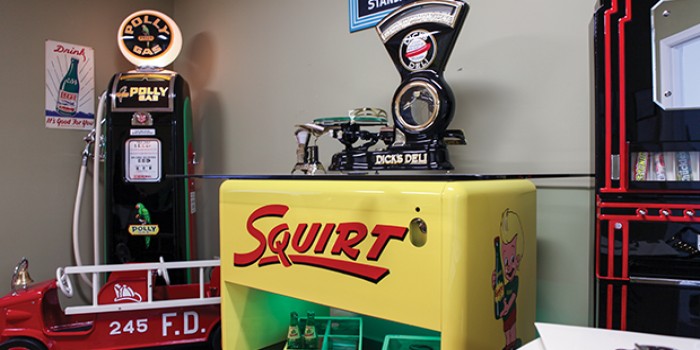
JUPITER, FL – March 8, 2017 – The rarest of antiques, collectibles, and art are restored to museum-quality in a Jupiter studio.
Rich Siegel’s newest challenge sits among the rare antiques in his Jupiter studio. A solid half-inch thick aluminum sculpture, suspended on its side, the piece is waiting to be painted. Even on its side, the 10-foot, three-inch tall piece is imposing. At its widest point, the piece is 56 inches. The modern interpretation of a woman’s figure, it resembles a complicated origami structure with five intersecting pieces, all meeting in a central spine. As an objective piece of art, it is stunning. As something that needs to be painted from all angles – including the waving hair and the bottom of the 15 feet – it is daunting – unless you are the man in whose studio the piece is sitting. Rich is unfazed, actually, he is excited by the challenge. “We’ve ordered an automobile rotisserie,” he says with a glint in his eye. “Then, we’ll take it into the paint booth, and get on it.”
Rich Siegel is the Owner and President of RMS Vintage, a shop that restores the rarest memorabilia and antiques, to what he calls “better than new” condition. He isn’t kidding. He is a rarity himself. As the owner of one of a handful of such businesses in the world, Rich is known for specializing in unique, one-of-a-kind pieces, including rare automobilia, scales, cash registers, and antique vending machines. And his passion for his job is evident.
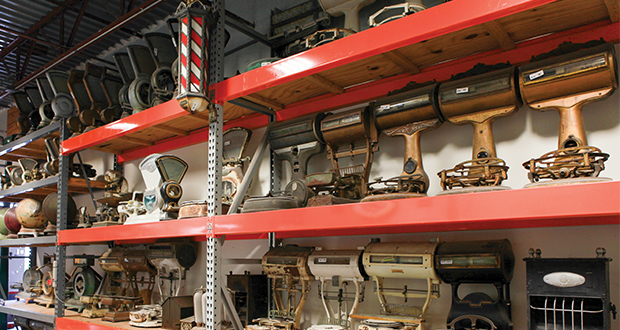
“Do you know what an automobile rotisserie is?” Rich asks. “It is exactly what it sounds like. It’s used to turn the cars while they are painted – and it is the only way to perfectly paint this piece. But the problem with this sculpture is, how to mount it on the rotisserie.”
The statue, “Psyche,” by Jennings of Jennings Artworks, has holes in the bottoms of its feet, but no holes in the top of its hair, which has created a real challenge: How to mount the sculpture onto the rotisserie so that it can spin and be painted with 360-degrees of paint – without drilling holes.
“I’ve got to figure out a way to mount this onto the rotisserie to get it into the paint booth – with only seven days to complete and deliver the piece.”
Most people would say that with a certain degree of stress in their voice. Not Rich. For him, this is simply what he does. His excitement makes a challenge that others walked away from seem like no big deal. “Nothing is impossible,” he says. “You just have to find a way to do it.” For the man who restores one-of-a-kind pieces, engineering a special bracket to mount a gigantic statue onto an automobile rotisserie is all in a day’s work.
AN ANTIQUE STATE OF MIND
It is perhaps fitting that the statue is named “Psyche.” Rich reads the artist’s statement about the piece: “By definition: The mind, soul, or spirit, as opposed to the body. In psychology, the psyche is the center of thought, feeling, and motivation, consciously and unconsciously directing the body’s reactions to its social and physical environment.”
Standing in the middle of his workshop, surrounded by his stock of rusted icons of the past in various stages of restoration, I am struck by this statement and by the emotions it evokes. Rich’s workshop itself is the center of years of thoughts, feelings, and motivation. The antiques that he lovingly saves speak not only of their histories, but also of our own. And at this point in time, many of the pieces are now the last examples known to exist.
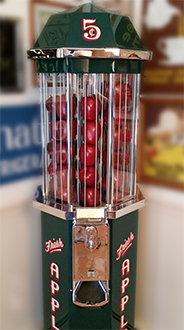
We walk over to a restored ice cream pushcart, the words “Tutti-Frutti Ice Cream” are emblazoned on the side and the front says, “O Sole Mio, Rain Rain go away come back some other day… Ernie wants to play & make $ to put away.” “This vintage 1930s pushcart is from Brooklyn, New York,” Rich says. “There really was an Ernie – Ernie Spumoni – and this was his actual cart, with the original 1938 license plate. The plate itself was almost beyond repair when I got it. I had to stretch and hammer it back into shape, which was a feat itself. It took countless hours, but you could never tell by the end result.” He’s right. The cart, with its four attached bells, looks brand-new. He continues, “It’s a one-of-a-kind piece owned by Ernie Spumoni. But more than that, we know that it had a happy history and it brings up such good memories of childhood.” As he speaks, you can almost feel Ernie Spumoni standing beside his cart once again, handing ice cream to happy children on a sunny day on the streets of Brooklyn. It is a window into a piece of America’s past.
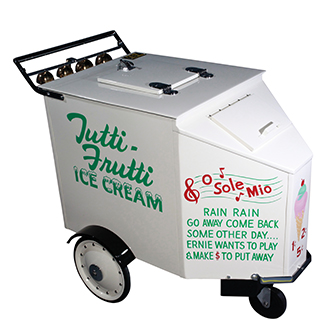
“Oh, yeah,” Rich affirms. “There is definitely history in here. These pieces speak to me as if they were alive. The past is definitely with us. Look at this.” He walks over to an enormous tool chest and removes a worn hammer. “This was my Dad’s. I use this all the time in my restoration work. It is priceless. I always think, ‘Thanks Dad’ when the pieces come together.”
He credits his Dad – and his Grandfather – with his obsession for antiques and mechanical things, saying that it started when he was young. “I used to ride the Long Island Railroad from Stoneybrook into Long Island City with my Dad. Then we would transfer to the subway, which would take us to Manhattan and 25 Park Place – the home of the Daily News and also, my family’s business, Typ E Co, which was located on the fourth floor. I would pack and label boxes, stock shelves, clean, but my favorite times were when I was allowed to work in the factory. And my absolute favorite part was when I got to rummage around the massive factory and find things: Old typewriters, cool old tools, you name it. And if I were lucky, my dad would take me with him on visits to typewriter dealers. Once they knew I was Paul Siegel’s grandson, it was free picking for me in their basements. I would rummage through hundreds of old antique typewriters piled up like scrap. I’d come up out of the basements absolutely filthy and I did not care because I had treasures in my arms.”
An obsession was born – and a skill was honed. “I used my Dad’s tools and old buffing wheel to polish parts in our garage, I made a little display in our garage of my cleaned up treasures” he says. Those typewriters were his first pieces. “I still use that buffing machine and many of my Dad’s and Grandfather’s tools every day for my restorations. When I hold their tools, I somehow feel as if they are still with me. It’s just a feeling I can’t describe.”
Now, vending machines and scales fill the shelves in Rich’s studio – “My era of pieces tends to be late 1800s to late 1940s,” he explains. “I just feel an affinity for the older, rarer pieces. Everything about the restoration work is true to the time period. These pieces are historic and, in a way, many people consider them art. They are certainly pieces of our past that are rapidly being lost. I want to honor them and bring them back to their original glory.”
THE ART PROCESS
But just how does one happen upon Ernie Spumoni’s ice cream pushcart? Or a 1940s Squirt ice box? Or a 116-year-old penny scale designed to weigh people – that advertises Wrigley’s Gum? These aren’t every day items.
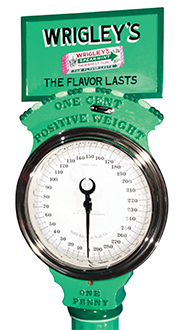
“We hunt at shows, auctions, and even in people’s garages,” Rich describes the first step in the restoration process. “Once we acquire a piece, we get right to it and completely disassemble it right down to the last screw. Most of the pieces we restore are hand-build one-offs, meaning that the original assembler had to actually fit and adjust the parts to make it all work. It now becomes our job to figure out how they did that because we have to re-assemble the pieces after all of the restoration work is completed and get them to actually work again.”
He continues, using the example of a scale. Once the scale is fully disassembled, each part must be categorized. Then, everything must be degreased. Using a grit blaster, they blast clean each part to bare metal and then they apply a primer coat of paint in their state-of-the-art paint booth. Following this, Rich’s colleague, Steve Martz, removes any dents or imperfections in the studio’s body room. Many pieces require welding or fabrication and this is one of Steve’s specialties. After that, they are re-primed in the paint booth, which is the final step before painting. Rich gives them a final inspection, a final sanding, and then one more coat of finish primer. When the primer has dried, the individual parts are scuffed and coated with the final “glass-like” finish. Rich mixes his own custom colors. “I work with the finest quality paints and materials available and take no shortcuts.”
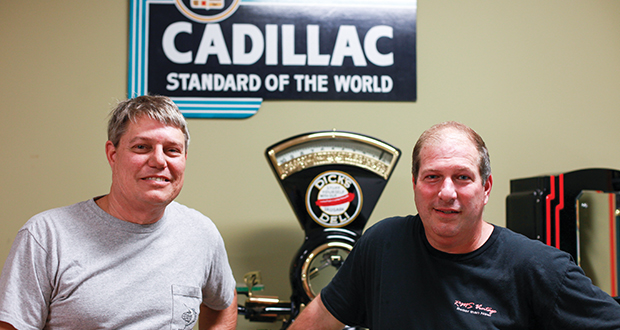
As a final step, the painted pieces are sent off for artwork or for hand lettering. “We do not use decals on any of our pieces,” Rich emphatically states. “Never. It would kill the integrity of the piece.”
Further, Rich only uses period-correct hardware to reassemble each piece. “You won’t find a Phillips-head screw in our shop, we only use slotted stainless and brass hardware, keeping in mind that the pieces we restore are pre-1950s and mostly late 1900s. Replacement parts are not an option if they are missing or broken, they either have to be acquired, repaired, or in some cases fabricated from scratch,” Rich explains. Even the paper charts in the scales are authentic to the time period, as is the glass, whenever possible. He continues, “Our glass work is local, Gunn’s Quality Glass & Mirror, our brass work is done right here in town by Treasure Coast Plating and Polishing for over 15 years, our artists are also local, Richard Baker, of Stuart, is a fifth generation Floridian, and Tom Mackey is from Jupiter. Not only do I believe in authenticity, I believe in doing business with local businesses and artists as much as possible. We have such a great town here, filled with so many talented people.”
RARE TREASURES, EASILY ACCESSIBLE
Rich is correct. Judging from the work on display in his Jupiter studio, he does indeed work with many of the town’s talented people, but he himself is high on that list. His studio is filled with museum-quality pieces. A 1940s-era gas pump, with its hand-painted Polly Gas Logo, lit with spotlighting, becomes a sculptural element in the corner of his office. An icebox from the 1940s has been returned to glory and serves – not soda – but rather as a cocktail table. An ornate 1880s barber chair reclines next to his desk. A sparkling candy machine beckons from across the room.
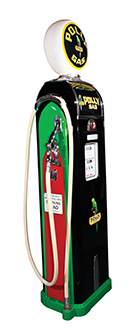
“Once upon a time, candy machines used to dispense 5-cent candy bars,” Rich says. 5-cent candy? It was a simpler, better time, wasn’t it? Rich laughs. “This is why I have such a passion for these pieces. They remind us of what was…and the stories our parents and grandparents used to tell. That’s why I love restoring these treasures.”
Whether it is a hundred-year-old scale or a modern sculpture, for Rich Siegel of RMS Vintage, restoring and protecting rare treasures is truly his life’s work. As he says, “Nothing is impossible. You just have to find a way to do it.”
To view RMS Vintage’s collection, visit www.RMSVintage.com. For more information, contact rmsvintage@aol.com, (561) 624-5587. By appointment only.
•
Photos courtesy of RMS Vintage
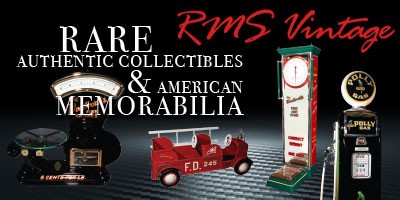
Antiques Dealers
Jupiter, Florida, United States |
561-624-5587,
email us